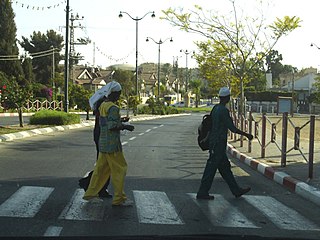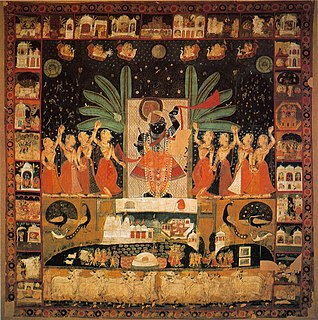 W
WThe African Hebrew Israelite Nation of Jerusalem is a spiritual group now mainly based in Dimona, Israel, whose members believe they are descended from the Twelve Tribes of Israel. The community now numbers around 5,000. Their immigrant ancestors were African Americans, many from Chicago, Illinois, who migrated to Israel in the late 1960s.
Caodaism is a monotheistic syncretic religion officially established in the city of Tây Ninh in southern Vietnam in 1926. The full name of the religion is Đại Đạo Tam Kỳ Phổ Độ.
 W
WGaudiya Vaishnavism, also known as Bengali Vaishnavism, Chaitanya Vaishnavism or the Gaudiya Vaishnava tradition, is a Vaishnava Hindu religious movement inspired by Chaitanya Mahaprabhu (1486–1534) in India. "Gaudiya" refers to the Gauda region of Bengal, with Vaishnavism meaning "the worship of Vishnu". Its theological basis is primarily that of the Bhagavad Gita and Bhagavata Purana, as interpreted by early followers of Chaitanya, such as Sanatana Goswami, Rupa Goswami, Jiva Goswami, Gopala Bhatta Goswami and others.
 W
WJainism, traditionally known as Jain Dharma, is an ancient Indian religion. Jain dharma traces its spiritual ideas and history through a succession of twenty-four leaders or tirthankaras, with the first in current time cycle being Lord Rishabhanatha, whom the Jain tradition holds to have lived millions of years ago, the twenty-third tirthankara Parshvanatha whom historians date to 8th or 7th century BCE, and the 24th tirthankara, Mahāvīra around 500 BCE. Jains believe that Jainism is an eternal dharma with the tirthankaras guiding every cycle of the Jain cosmology.
 W
WMahima Dharma is an Indian religion practiced primarily in Odisha and nearby states. It was started by people from the underprivileged castes in a caste-based Hindu society as a social reform and protest against the dominance of Brahmanism. The religious movement was based on the condemnation of all religious customs set by the rich and upper-class society generally.
 W
WPushtimarg, also known as Pushtimarg sampradaya or Vallabha sampradaya, is a subtradition of Rudra Sampradaya (Vaishnavism). It was founded in the early 16th century by Vallabhacharya (1479–1531) and is focused on Krishna. A bhakti (devotional) school, Pushtimarg was expanded by the descendants of Vallabhacharya, particularly Gusainji. Its values are derived from and its universal-love-themed devotional practices center around the legendary amorous plays of youthful Krishna, such as those found in the Bhagavata Purana and those related to Mount Govardhana. Pushtimarg sampradaya recognizes Krishna by many names and epithets, such as Sri Nathji, Sri Navanitpriyaji, Sri Madanamohanji, Sri Mathureshji, Sri Gokulnathji, Sri Vittalnathji and Sri Dwarkadhishji.
 W
WThe Rosicrucian Fellowship (TRF) was founded in 1909 by Max Heindel with the aim of heralding the Aquarian Age and promulgating "the true Philosophy" of the Rosicrucians. It claims to present Esoteric Christian mysteries or esoteric knowledge, alluded to in Matthew 13:11 and Luke 8:10, to establish a meeting ground for art, religion, and science and to prepare the individual through harmonious development of the mind and the heart for selfless service of humanity.
 W
WSri Devananda Gaudiya Math is situated at Teghori Pada in Sri Nabadwip dham of district Nadia in the West Bengal state of India, and is a prominent holy place of the Gaudiya Vaisnavas. It is located in the middle of the place earlier known as Koladvipa. The Math has been continuing as a famous religious spot thronged by thousands of devotees every year.
 W
WThe Swaminarayan Sampradaya is a Hindu sampradaya which was founded in 1801 by Sahajanand Swami, who is worshipped as Swaminarayan, the supreme manifestation of God, by his followers. Under Swaminarayan’s leadership the sampradaya grew to more than 100,000 followers and 3,000 swamis (monks) by the time of his death in 1830.
 W
WYiguandao / I-Kuan Tao (traditional Chinese: 一貫道; simplified Chinese: 一贯道; pinyin: Yīguàn Dào; Wade–Giles: I1-Kuan4 Tao4), meaning the Consistent Way or Persistent Way, is a Chinese salvationist religious sect that emerged from the Xiantiandao ("Way of Former Heaven") tradition in the late 19th century, in Shandong, to become China's most important redemptive society in the 1930s and 1940s, especially during the Japanese invasion. In the 1930s Yiguandao spread rapidly throughout China led by Zhang Tianran, who is the eighteenth patriarch of the Xiantiandao lineage, among thousands of other movements that thrived since the collapse of the Qing dynasty in 1911.